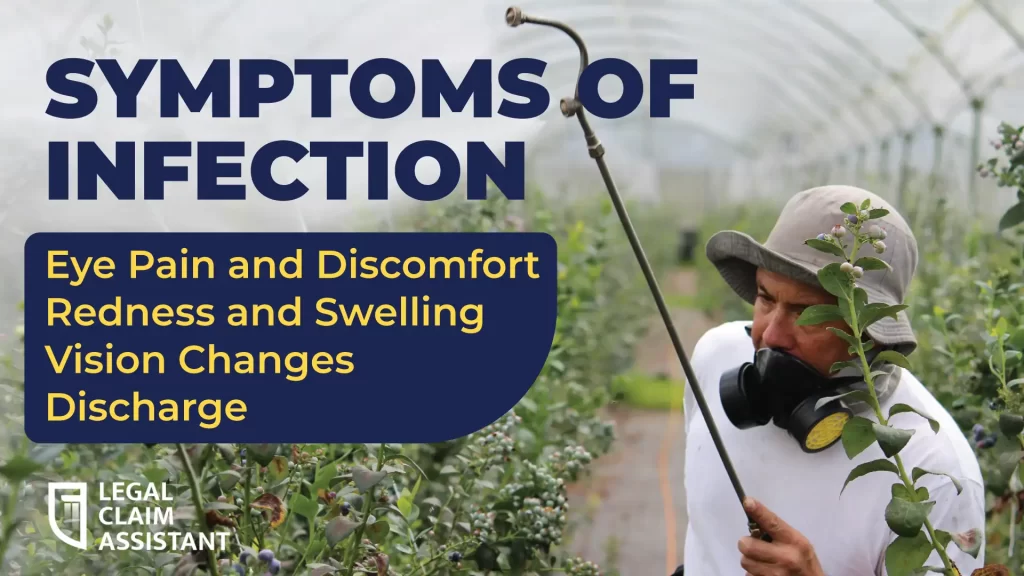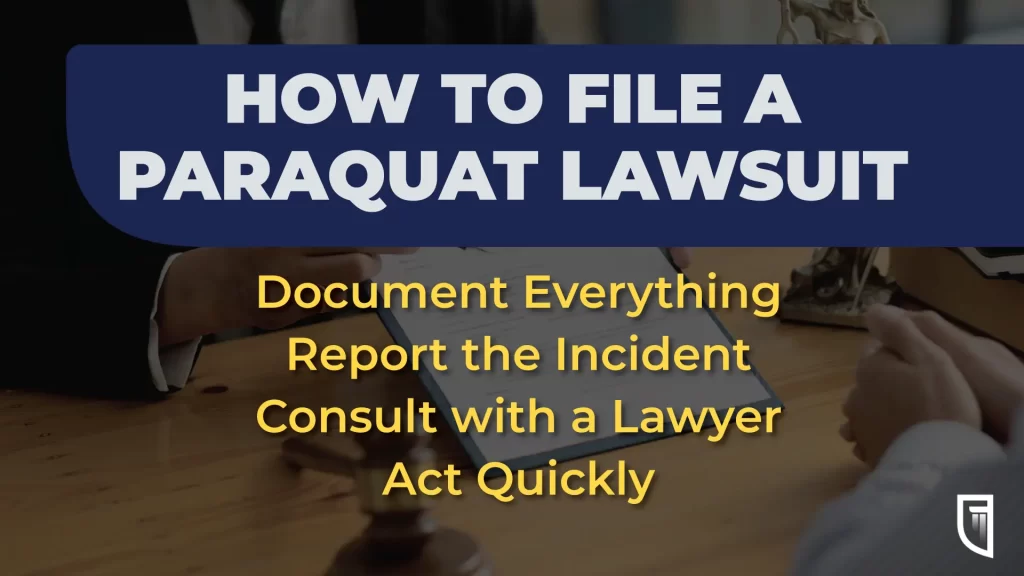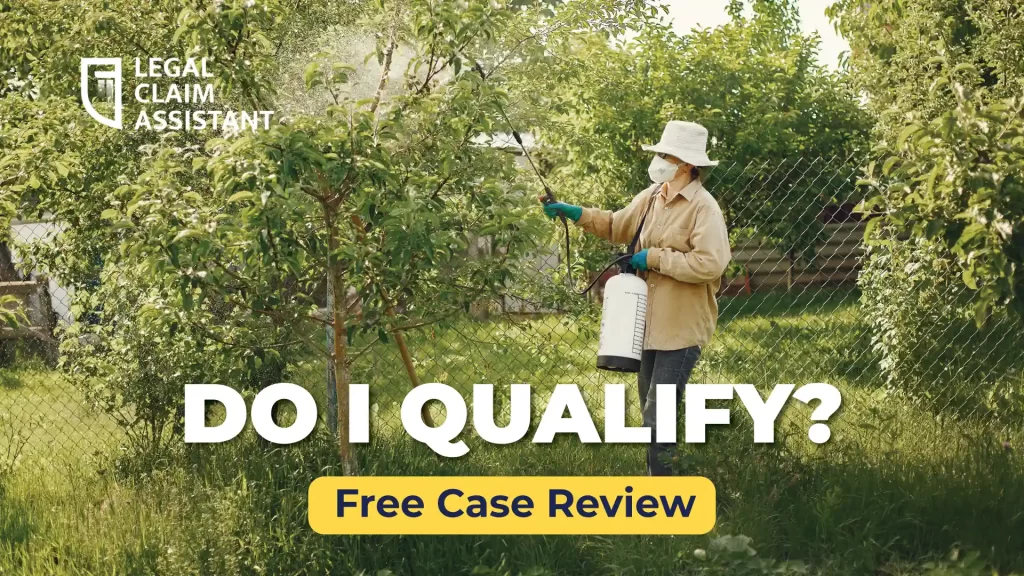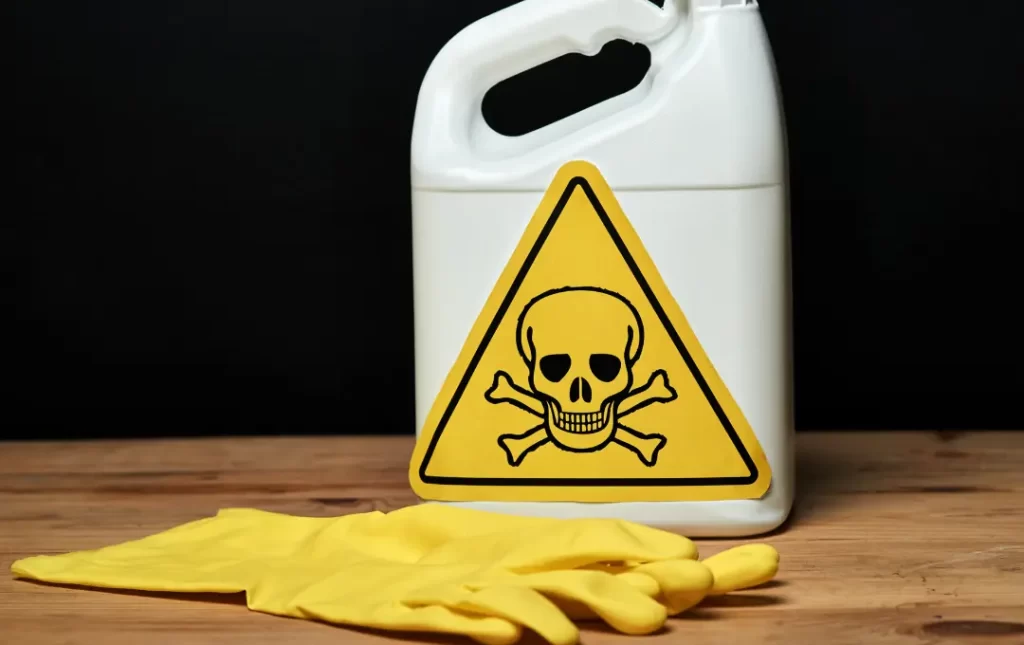Paraquat Lawsuit
The Paraquat Lawsuit centers on the serious allegations that exposure to the herbicide paraquat is linked to the development of Parkinson’s disease. Victims and their families are seeking justice and compensation through litigation, asserting that manufacturers failed to warn of the risks associated with its use. This ongoing legal battle highlights significant health concerns and the pursuit of accountability in the face of debilitating illness.
Written by: Sarah from Legal Claim Assistant, Last updated: April 22, 2024
Table of Contents

About the Paraquat Lawsuit
The ongoing paraquat lawsuits have garnered significant attention due to the serious health risks linked to the herbicide, particularly its association with Parkinson’s disease. Individuals who have developed Parkinson’s disease after paraquat exposure are pursuing justice through paraquat Parkinson’s disease lawsuits. These legal actions challenge paraquat manufacturers over insufficient warnings about the herbicide’s risks.
Paraquat litigation includes individual lawsuits and class action cases, where plaintiffs allege that exposure to paraquat has led to severe health issues, including motor symptoms and other Parkinson’s disease symptoms. The legal landscape is marked by key developments such as bellwether trials, which test the strength of the causal links in early cases that may influence outcomes in subsequent paraquat lawsuits.
Victims seeking a paraquat lawsuit settlement face a complex legal process, which includes navigating the multifaceted aspects of paraquat class action lawsuits and managing the rigorous demands of bellwether test trials. The outcomes of these trials, including the first bellwether test trial, play a crucial role in shaping potential settlements and defining legal precedents.
Legal Claim Assistant offers vital support to those affected, connecting them with experienced paraquat lawsuit attorneys who specialize in this niche of toxic herbicide litigation. These attorneys are equipped to handle the intricacies of such cases, from proving poisoning symptoms from paraquat to arguing in supreme court settings if necessary.
For those considering legal action, understanding the link between paraquat exposure and Parkinson’s disease, and the potential for significant settlement amounts, is critical. Legal Claim Assistant and its network of plaintiffs’ lawyers are committed to advocating for the rights of those harmed by paraquat, ensuring they receive the compensation and justice they deserve.
Need help filing a Paraquat Claim?

Understanding Paraquat and Its Usage
Paraquat dichloride, commonly known as paraquat, is a highly effective and widely used herbicide renowned for its ability to control weeds and grass quickly. It is particularly favored in large-scale farming due to its efficiency in clearing fields prior to the planting of crops. However, paraquat’s high toxicity also makes it a substance of significant health concern, leading to serious implications, including acute poisoning and long-term health effects such as Parkinson’s disease.
Paraquat has been under scrutiny for decades, primarily due to its link to developing Parkinson’s disease after prolonged exposure. Scientific evidence supports that exposure to this toxic chemical, even at low levels, can increase the risk of Parkinson’s significantly. The Environmental Protection Agency (EPA) has imposed regulations to manage its use, but the herbicide is still widely available and used, leading to ongoing legal battles. The plaintiffs in paraquat lawsuits assert that paraquat manufacturers failed to adequately warn of the health risks, resulting in paraquat litigation, including numerous paraquat class action lawsuits and multidistrict litigation (MDL).
Paraquat exposure can occur through various means, including direct handling of the herbicide or indirect exposure near treated fields. Symptoms of paraquat poisoning can range from acute kidney failure to severe motor symptoms, which mirror those of Parkinson’s disease. This has led to an increased filing of paraquat Parkinson’s disease lawsuits, aiming to hold manufacturers accountable for the health risks associated with the herbicide.
The History of Paraquat as an Herbicide
Paraquat was first synthesized in 1882, but its herbicidal properties were not recognized until the mid-20th century. It quickly became a popular choice for weed and grass control due to its effectiveness at low application rates. Despite its benefits for agricultural productivity, the potential health risks were soon observed, with cases of poisoning and long-term health effects being reported. This led to restrictions and bans in several countries, though it remains in use under strict regulations in others, including the United States.
The controversy surrounding paraquat has spurred ongoing legal actions, with paraquat lawsuit settlements reflecting the serious nature of the allegations against its safety. As legal processes such as bellwether trials unfold, they continue to shed light on the scientific causation evidence linking paraquat to Parkinson’s disease, influencing both public perception and regulatory actions potentially leading to a ban on paraquat.
In conclusion, while paraquat remains a powerful agricultural tool, its potential risks demand careful consideration and management. Legal Claim Assistant remains committed to providing support and information to those affected by paraquat, guiding them through the complex legal landscape surrounding paraquat lawsuits.
Current Uses and Regulations
Today, the use of paraquat is highly regulated in many countries. In the United States, it is classified as a restricted use pesticide, which means it can only be used by licensed applicators. These regulations are intended to prevent accidental poisoning and minimize environmental and health risks. Despite these precautions, the use of paraquat in agriculture remains prevalent due to its effectiveness in controlling resistant weeds.
The controversy surrounding paraquat has spurred ongoing legal actions, with paraquat lawsuit settlements reflecting the serious nature of the allegations against its safety. As legal processes such as bellwether trials unfold, they continue to shed light on the scientific causation evidence linking paraquat to Parkinson’s disease, influencing both public perception and regulatory actions potentially leading to a ban on paraquat.
In conclusion, while paraquat remains a powerful agricultural tool, its potential risks demand careful consideration and management. Legal Claim Assistant remains committed to providing support and information to those affected by paraquat, guiding them through the complex legal landscape surrounding paraquat lawsuits.
The Link Between Paraquat and Parkinson’s Disease
The connection between paraquat exposure and the development of Parkinson’s disease has become a focal point of both scientific research and legal scrutiny. Multiple studies and lawsuits allege that prolonged exposure to paraquat, a toxic herbicide, significantly increases the risk of developing Parkinson’s disease, particularly among agricultural workers and those living near treated fields.
Paraquat dichloride, the active ingredient in many commercial herbicides, has been shown to cause various symptoms associated with poisoning, which mirror the motor symptoms of Parkinson’s disease. This has led to a surge in paraquat Parkinson’s disease lawsuits, where plaintiffs assert that exposure to the chemical caused them to develop the neurological condition. The paraquat litigation landscape includes numerous paraquat lawsuits aiming to hold manufacturers accountable, emphasizing the need for a potential ban on paraquat due to its health risks.
The Environmental Protection Agency (EPA) has been involved in regulating paraquat, yet the herbicide remains in use under strict conditions. Paraquat attorneys and paraquat plaintiffs have brought forth cases under paraquat class action lawsuits and individual paraquat lawsuits, some of which have reached the paraquat MDL (multidistrict litigation) stage, seeking paraquat settlements for the harm caused.
Scientific Studies Supporting the Causal Link
The causal link between paraquat and Parkinson’s disease has been reinforced by extensive scientific evidence. Research has documented how paraquat’s chemical properties may contribute to cellular damage that leads to Parkinson’s, with symptoms such as acute kidney failure and severe neurological impairments. These studies have been critical in paraquat class action litigation and are often cited by plaintiffs’ paraquat lawyers during trials and in settlement negotiations.
Notably, the Unified Parkinson’s Advocacy Council has highlighted the increased risk and has been instrumental in advocating for stricter regulations and more comprehensive studies to fully understand paraquat’s impact on human health. This scientific backing has been pivotal in progressing paraquat lawsuits through the legal process, including influencing the outcomes of bellwether trials which help determine the course of future paraquat Parkinson’s disease lawsuits within the paraquat MDL.
In conclusion, as new paraquat lawsuits emerge and more scientific data becomes available, the link between paraquat and Parkinson’s disease remains a significant concern. The ongoing legal battles and scientific investigations continue to shed light on the potential dangers of paraquat, guiding regulatory decisions and legal strategies aimed at protecting public health and securing justice for affected individuals.

Overview of Paraquat Lawsuits
The landscape of paraquat lawsuits has evolved significantly over the years, marked by numerous legal milestones and evolving scientific understanding. These lawsuits primarily revolve around the alleged link between paraquat exposure and the development of Parkinson’s disease, a debilitating neurological condition.
Paraquat, a highly toxic herbicide, has been used extensively in agriculture for weed and grass control. However, its potential neurological effects have become a major concern, leading to a surge in litigation. The plaintiffs in these cases argue that prolonged exposure to paraquat, through either direct application or indirect contact, has contributed to developing Parkinson’s disease. These lawsuits target manufacturers of paraquat, accusing them of failing to provide adequate warnings about the risks associated with its use.
Key Cases and Legal Milestones
The legal journey of paraquat lawsuits began to gain significant momentum in the late 2010s as more scientific studies supported the link between paraquat and Parkinson’s disease. One of the pivotal moments in paraquat litigation was the formation of the Paraquat MDL (Multidistrict Litigation), which consolidated many individual cases under one federal judge to streamline the pretrial proceedings and facilitate a more efficient process.
The first bellwether trials, which are test cases that help predict trends in litigation and guide settlement negotiations, began in recent years. These trials are crucial as they provide a glimpse into how juries might respond to the evidence presented regarding paraquat’s toxicity and its alleged effects on users’ health.
In parallel, advocacy groups like the Unified Parkinson’s Advocacy Council have been instrumental in raising awareness and pushing for more stringent regulations and potentially banning the chemical. Efforts by these groups have led to significant public discourse about the safety of paraquat and its continued use.
Legal proceedings have also seen an emphasis on scientific evidence, with both sides presenting data and expert testimonies to establish or refute the causal link between paraquat and Parkinson’s disease. The role of the EPA and its regulations on paraquat have also been scrutinized in these lawsuits, with plaintiffs arguing that the regulatory measures were insufficient to protect users from significant health risks.
As the number of lawsuits grows, so do the legal complexities. Paraquat attorneys continue to file new cases, and the outcomes of ongoing and future bellwether trials will likely influence the strategies of both plaintiffs and defendants in upcoming legal battles.
The paraquat lawsuits represent a significant chapter in the field of mass tort litigation, reflecting a broader concern about the intersection of public health, environmental safety, and corporate responsibility. Each new legal milestone not only shapes the course of ongoing litigation but also impacts future regulatory policies and public health measures. As these cases progress, they not only seek justice for the affected individuals but also aim to prevent future harm by holding manufacturers accountable and potentially leading to more robust safety standards for toxic chemicals.
Paraquat Exposure and Health Risks
Paraquat dichloride, a widely used herbicide known for its effectiveness in controlling weeds and grass, is also notorious for its highly toxic nature. Exposure to paraquat has been linked with several serious health risks, primarily Parkinson’s disease, a progressive neurological disorder characterized by motor symptoms such as tremors, stiffness, and slowed movement.
Research indicates that both direct and indirect exposure to paraquat can significantly increase the risk of developing Parkinson’s disease. Those most at risk include agricultural workers who handle the herbicide and communities near treated areas. The toxicity of paraquat also extends to acute risks such as paraquat poisoning, which can be fatal if ingested and cause serious health issues even from skin exposure or inhalation.
Identifying Symptoms of Paraquat Poisoning
Symptoms of paraquat poisoning are severe and require immediate medical attention. Early signs include nausea, vomiting, and abdominal pain, which may quickly escalate to more severe health issues such as respiratory difficulties, organ failure, and ultimately, death. Chronic exposure, even at low levels, can lead to long-term effects such as lung damage and scarring, kidney failure, and neurological impairments akin to those seen in Parkinson’s disease.
Legal Rights and Paraquat Litigation
The surge in paraquat lawsuits reflects growing awareness and concern over the herbicide’s safety. Individuals who have developed Parkinson’s disease and other serious health conditions allegedly due to paraquat exposure are seeking justice and compensation through the legal system. These lawsuits claim that the manufacturers of paraquat failed to provide adequate warnings about the risks and continued to promote their products despite knowing the potential consequences.
Understanding Your Legal Standpoint
If you believe you have been affected by paraquat exposure, understanding your legal rights is crucial. Plaintiffs in paraquat lawsuits are typically required to demonstrate a causal link between their exposure to paraquat and their medical condition. This involves detailed medical records, expert testimonies, and often, genetic testing to support claims that paraquat exposure contributed significantly to their disease development.
Paraquat litigation often involves complex legal and scientific arguments, and the role of experienced paraquat lawyers is to navigate these complexities effectively. These attorneys are instrumental in gathering necessary evidence, representing clients in court, and negotiating settlements. The legal process for paraquat cases can vary widely, from individual lawsuits to class actions and multidistrict litigation (MDL), depending on the number of plaintiffs and the similarities in their cases.
The Environmental Protection Agency (EPA) and other regulatory bodies are also key players in this ongoing issue. Their regulations and bans, or lack thereof, on paraquat use significantly impact legal proceedings and public health policies. Advocacy for stricter regulations or a complete ban on paraquat continues to grow as more scientific evidence links its use to severe health risks.
Paraquat settlements have varied, with some cases resulting in significant compensation for the plaintiffs, reflecting the serious nature of their claims. Each case’s outcome depends on a multitude of factors, including the strength of the causal link between paraquat exposure and Parkinson’s disease, the severity of the plaintiff’s symptoms, and the legal strategy employed.
Overall, paraquat litigation underscores a critical public health issue and highlights the need for rigorous safety standards for agricultural chemicals. As new lawsuits continue to be filed, and legal battles are fought, the narrative of paraquat and its implications for public health and safety will likely continue to evolve, guided by both legal and scientific developments.
Find out how much your paraquat payout could be:

Filing a Paraquat Lawsuit
Filing a paraquat lawsuit requires a thorough understanding of the legal framework and a comprehensive preparation of documentation and evidence. Individuals who have suffered from the effects of paraquat exposure, particularly those who have developed Parkinson’s disease, may consider taking legal action against the manufacturers of this toxic herbicide.
The initial step in initiating a paraquat lawsuit involves confirming paraquat exposure. This can be challenging, as symptoms such as Parkinson’s disease may appear years after exposure. Plaintiffs must establish a direct link between their health condition and paraquat exposure, which often involves gathering medical records, employment history, and expert testimonies that support the claim of exposure and resultant health issues.
Paraquat lawyers play a crucial role in navigating the complex legal landscape, from filing the lawsuit to representing the plaintiffs in court. These specialized attorneys are experienced in handling toxic chemical cases and are essential for managing the intricate details of paraquat litigation.
Necessary Documentation and Evidence
Successful paraquat lawsuits hinge on the quality and comprehensiveness of the evidence presented. Necessary documentation includes medical records that diagnose Parkinson’s disease or related symptoms, proof of paraquat exposure, and any relevant employment records if exposure occurred during agricultural work. Plaintiffs may also need to provide expert analyses from medical professionals and toxicologists who can testify to the effects of paraquat on the human body and specifically link it to the symptoms experienced by the plaintiff.

Paraquat Class Action Lawsuits
As the number of paraquat exposure cases has increased, many have been consolidated into class action lawsuits or multidistrict litigation (MDL) to efficiently handle claims that share common issues and defendants. This consolidation helps streamline the legal process and can lead to more substantial collective settlements.
Benefits of Joining a Class Action
Joining a paraquat class action lawsuit can offer several advantages. It allows individual plaintiffs to share the costs of litigation, which can be substantial in complex cases involving toxic substances like paraquat. Furthermore, class actions can amplify the impact of the litigation, putting greater pressure on the defendants to settle and address the harmful effects of their products.
Class actions also benefit from the collective strength of multiple plaintiffs who have suffered similar injuries, which can lead to more consistent and fair compensation for all involved. Additionally, outcomes from bellwether trials in class actions can set precedents and influence the resolution of subsequent cases in the MDL.
Paraquat class action lawsuits not only seek compensation for the plaintiffs but also aim to hold manufacturers accountable for their negligence in failing to warn about the dangers of paraquat. These lawsuits push for stronger regulations and potentially a complete ban on paraquat to prevent future health issues.
The Ongoing Legal Process
The legal process for paraquat lawsuits involves several stages, including the filing of complaints, pre-trial discovery, bellwether trials, and potential settlement negotiations. Throughout these stages, the role of experienced paraquat attorneys is pivotal. They guide plaintiffs through the complexities of legal proceedings, ensuring that all necessary documentation is accurately presented and that the plaintiffs’ rights are vigorously defended.
As cases progress, updates from paraquat MDLs and trial outcomes continue to influence the landscape of paraquat litigation. Each new development helps shape the strategies used by plaintiffs’ attorneys and affects the overall dynamics of pursuing justice for those harmed by paraquat exposure.
In conclusion, paraquat lawsuits serve as a critical mechanism for affected individuals to seek justice and compensation. They also play an essential role in advocating for public health and safety by challenging the practices of powerful herbicide manufacturers and pushing for regulatory reforms.
Need help with your Claim?
The Role of Paraquat Lawyers
Paraquat lawyers are essential in navigating the complex legal challenges associated with paraquat lawsuits, particularly for clients who have developed Parkinson’s disease due to exposure to this toxic herbicide. These specialized attorneys possess a deep understanding of the legal, medical, and scientific aspects of paraquat cases, enabling them to advocate effectively for their clients.
The primary responsibility of paraquat lawyers is to establish a causal link between paraquat exposure and the development of Parkinson’s disease. This involves gathering comprehensive evidence, including medical records that document Parkinson’s disease symptoms and any history of paraquat exposure. Lawyers also collaborate with medical experts to substantiate claims that paraquat exposure directly contributed to the client’s condition.
Choosing the Right Attorney for Your Case
Selecting the right paraquat attorney is crucial for affected individuals. A qualified lawyer should have a proven track record in handling similar toxic exposure cases and a thorough understanding of the specific nuances related to paraquat litigation. The attorney’s experience with bellwether trials and their knowledge of the paraquat class action MDL (multidistrict litigation) processes can significantly influence the outcome of a case.
Settlements and Compensation in Paraquat Cases
Settlements in paraquat cases provide compensation for individuals who have suffered health consequences as a result of paraquat exposure. These settlements are intended to cover medical expenses, loss of income, and other damages such as pain and suffering and loss of quality of life. Paraquat lawyers play a critical role in negotiating these settlements, ensuring that their clients receive fair compensation based on the severity of their symptoms and the impact on their lives.
Analyzing Past Settlement Amounts
Examining past settlement amounts in paraquat lawsuits offers valuable insights into the potential outcomes of new cases. Settlement amounts can vary widely based on the extent of exposure, the severity of the plaintiff’s Parkinson’s disease symptoms, and the strength of the evidence linking the disease to paraquat exposure. Paraquat attorneys analyze these factors and previous case results to guide their clients on what they might expect in terms of compensation.
Paraquat litigation also involves addressing broader issues such as the need for stricter regulations and potential bans on the herbicide. Advocacy by paraquat lawyers not only focuses on individual compensations but also on effecting change at the policy level to prevent future cases of poisoning and illness related to paraquat exposure.
As new developments arise, such as findings from scientific studies and updates in legal standards, paraquat lawyers must stay informed to adjust their strategies effectively. The ongoing legal battles, including bellwether trials and class action lawsuits, continue to shape the landscape of paraquat litigation, influencing both current lawsuits and future regulatory actions.
In summary, paraquat lawyers are indispensable in the fight against the manufacturers of paraquat. They provide not only legal representation but also a voice for those affected by this dangerous chemical, advocating for justice and safety improvements to protect public health.

The Future of Paraquat Use and Legalities
The future of paraquat use and its legal implications are under intense scrutiny as public awareness and scientific scrutiny link the herbicide to serious health risks, particularly Parkinson’s disease. This scrutiny has propelled numerous paraquat lawsuits, where plaintiffs have developed Parkinson’s disease symptoms allegedly due to paraquat exposure.
Potential Bans and Regulatory Changes
In light of the increasing lawsuits and the consolidation of cases into a paraquat class action MDL (multidistrict litigation), there is growing pressure on regulatory bodies like the Environmental Protection Agency to reevaluate and potentially ban paraquat. The legal process in ongoing paraquat litigation, including bellwether trials, is closely watched as it could influence regulatory decisions and lead to stricter control measures or a complete ban of the herbicide.
The causal link between paraquat and Parkinson’s disease is a critical aspect of these legal battles. Plaintiffs’ lawyers argue that prolonged exposure to the toxic chemical, even indirectly, increases the risk of developing debilitating conditions. The outcomes of these trials and the scientific evidence presented could lead to significant legal and regulatory shifts.
The paraquat lawsuits also test the legal frameworks of mass torts, challenging how such cases are managed and resolved in the judicial system. With the paraquat mdl judge overseeing bellwether test trials, each case contributes to a larger understanding of the herbicide’s impact and the adequacy of the manufacturers’ warnings to users.
As new paraquat lawsuits emerge and current cases progress, the legal landscape will continue to evolve. This could potentially lead to a paradigm shift in how toxic herbicides like paraquat are regulated and litigated in the United States, emphasizing the need for safer agricultural practices and better protection for public health. Meanwhile, the unified efforts of plaintiffs’ attorneys are crucial in navigating this complex and evolving legal environment, seeking justice for affected individuals and pushing for significant changes in public safety standards.
Support and Resources for Paraquat Exposure Victims
Victims of paraquat exposure face significant challenges, not only due to the health risks associated with the herbicide but also in navigating the legal landscape to seek justice and compensation. Understanding the resources available can provide essential support.
Community and Legal Support Networks
For those affected by paraquat, particularly individuals developing Parkinson’s disease after exposure, finding reliable support is crucial. Community groups, often facilitated through social media and health advocacy organizations, provide a platform for sharing experiences and advice. These networks can be invaluable for emotional support and for exchanging information on managing symptoms like motor dysfunction and other Parkinson’s disease symptoms.
Legal support is equally crucial. A robust network of plaintiff’s paraquat lawyers specializes in handling cases related to paraquat lawsuits, including class action lawsuits and individual paraquat Parkinson’s disease lawsuits. These attorneys are well-versed in the specifics of paraquat litigation, from identifying the causal link between paraquat exposure and developing Parkinson’s to navigating the complex legal process, including participating in bellwether trials.
Paraquat lawsuit settlements have varied, with some cases achieving significant settlement amounts reflecting the severity of the exposure’s impact. Legal professionals can help victims through the paraquat class action mdl, ensuring they are properly represented and their cases are heard. Paraquat mdl judge Nancy Rosenstengel oversees many of these proceedings, aiming to ensure fair outcomes for all parties involved.
Victims can also benefit from participating in mass torts, which may involve bellwether test trials that help determine the course of litigation for related cases. Each trial and lawsuit adds to the body of evidence needed to establish a strong causal link between paraquat and its severe effects, potentially influencing future legal and regulatory outcomes.
For those new to the legal aspects, consulting with a paraquat lawsuit attorney is recommended. These legal experts can provide guidance on the necessary steps to file a lawsuit, including gathering medical records, filling out a plaintiff assessment questionnaire, and understanding the genetic factors that might influence their case.
Overall, the support from community networks and specialized legal professionals forms a foundation that empowers paraquat exposure victims to advocate for their health and legal rights effectively.
Need help with your Claim?
How Legal Claim Assistant can help
Legal Claim Assistant stands as a crucial ally for individuals impacted by paraquat, especially those suffering from Parkinson’s disease as a result of exposure to this toxic herbicide. Our platform is dedicated to guiding paraquat exposure victims through the intricate legal landscape, ensuring they receive the support and compensation they deserve.
Navigating Paraquat Lawsuits
For victims contemplating a paraquat lawsuit or already involved in one, Legal Claim Assistant provides essential resources and connections to experienced paraquat lawsuit attorneys. Our network includes specialists in paraquat Parkinson’s disease lawsuits who are deeply familiar with the complexities of paraquat litigation, including class action lawsuits and individual claims.
We help clarify the process from the initial filing of a paraquat lawsuit to understanding potential paraquat settlement amounts. Victims can find detailed guides on identifying poisoning symptoms from paraquat, the risks associated with indirect paraquat exposure, and the legal implications of their cases.
Class Action and MDL Support
Our platform is particularly valuable for those involved in paraquat class action mdl or seeking to join new paraquat lawsuits. We provide updates on bellwether trials, which are critical in shaping the landscape of paraquat litigation and influencing potential settlements. Legal Claim Assistant ensures that plaintiffs are well-informed about the progression of paraquat mdl averaged trials and upcoming first bellwether test trials.
For those affected by ongoing legal proceedings, such as the paraquat mdl class action or specific trials like the six paraquat lawsuits, we offer insights into the legal process, including developments from bellwether trials and Supreme Court arguments. We also provide guidance on participating effectively in these trials, from preparing for plaintiff depositions to understanding the significance of causal links established in court.
Maximizing Compensation
Understanding the compensation potential, including paraquat settlement amounts and what factors may influence these settlements, is vital. Legal Claim Assistant helps plaintiffs understand how factors like motor symptoms, health risks from prolonged exposure, and the strength of the causal link between paraquat and Parkinson’s disease can impact their legal claims.
Additionally, for families and representatives of deceased plaintiffs, our platform offers compassionate and comprehensive support to navigate the complexities of filing claims and participating in ongoing litigation.
Through Legal Claim Assistant, paraquat lawsuit plaintiffs gain access to a wealth of knowledge and a supportive network, empowering them to pursue justice and significant compensation effectively. Whether you’re facing a new paraquat lawsuit or are amidst a challenging legal battle, Legal Claim Assistant provides the resources and expertise necessary to navigate this challenging journey.
Written by:
Nicky from LegalClaimAssistant.com
LegalClaimAssistant.com simplifies the process of pursuing legal action. Access information, lawsuit guides, and updates on drugs, products, and other matters that may impact you.
4 References
- Holpuch, Amanda. “Two Army Veterans Awarded $110 Million in 3M Earplug Lawsuit.” The New York Times. January 28, 2022. Retrieved on May 12, 2022 from https://www.nytimes.com/2022/01/28/us/veterans-earplugs- 3m-lawsuit.html
- LexisNexis® Legal Insights. “Product liability & strict liability.” January 06, 2021. Retrieved on May 5, 2022 from https://www.lexisnexis.com/community/insights/legal/b/thought-leadership/posts/understanding-the- interplay-between-strict-liability-and-products-liability
- National Highway Traffic Safety Administration. “Letter to Tesla: Full Self-Driving Software May Cause Crash.” Retrieved from: https://static.nhtsa.gov/odi/rcl/2023/RCAK-23V085-2525.pdf. Accessed on February 17, 2023.
- Unified Parkinson’s Advocacy Council. “Paraquat Dichloride Registration Review.” July 24, 2017. Retrieved on May 12, 2022 from https://files.michaeljfox.org/Paraquat_letter_FINAL.pdf




